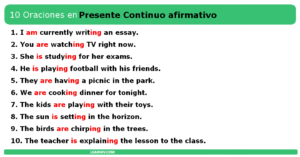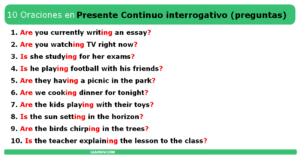Hay varios verbos que no se suelen utilizar en presente continuo (también conocido como presente progresivo).
Algunos verbos no se suelen utilizar en presente continuo porque representan estados, cualidades o verbos que no son de acción. Estos verbos describen condiciones o características que no suelen asociarse con acciones en curso o temporales. He aquí algunas razones por las que ciertos verbos no se utilizan habitualmente en presente continuo:
Verbos no continuos (estativos)
Estos verbos describen estados o condiciones más que acciones y no suelen usarse en presente continuo (progresivo). Por ejemplo, decimos " I understand " en lugar de " I am understanding ".
| Verbo estativo | Presenta Simple | Presente Continuo |
|---|---|---|
| Believe | She believes his story. | She is believing his story. |
| Understand | They understand the task. | They are understanding the task. |
| Know | Do you know me? | Are you knowing me? |
| Love | She loves the new movie. | She is loving the new movie. |
| Hate | They hate this weather. | They are hating this weather. |
| Prefer | He prefers the blue one. | He is preferring the blue one. |
| Want | Do you want a cup of coffee? | Are they wanting a cup of coffee? |
| Need | She needs any assistance. | She is needing any assistance. |
| Belong | It does not belong to him. | It is not belonging to him. |
| Feel | She does not feel well today. | She is not feeling well today. |
Nota: aunque los verbos de percepción pueden emplearse en presente continuo (progresivo) para describir sensaciones en curso o temporales, suelen utilizarse en presente simple para expresar percepciones generales o habituales. El presente continuo se utiliza normalmente cuando la acción o sensación está ocurriendo en el momento de hablar.
Verbos de pensamiento
Los verbos que describen actividades mentales o pensamientos no suelen utilizarse en presente continuo. Por ejemplo, decimos " I think you're right" en lugar de "I am thinking you're right".
| Verbo de pensar | Presente Simple | Presente Continuou |
|---|---|---|
| think | I think it's a good idea. | I am thinking about my future plans. |
| believe | She believes in ghosts. | She is believing in herself. |
| consider | They consider him a good candidate. | They are considering their options. |
| suppose | I suppose you're right. | I am supposing that it will rain later. |
| imagine | He imagines a world without war. | He is imagining himself on a beach. |
Nota: Aunque los verbos de pensamiento pueden usarse en presente continuo (progresivo) para describir pensamientos o contemplaciones en curso, suelen usarse en presente simple para expresar pensamientos, creencias u opiniones generales. El presente continuo se utiliza normalmente cuando el proceso de pensamiento está ocurriendo en el momento de hablar.
Verbos de posesión
Los verbos que indican propiedad o posesión no suelen utilizarse en presente continuo. Por ejemplo, decimos " I have a car" en lugar de "I am having a car".
| Verbo de posesión | Presente Simple | Presente Continuou |
|---|---|---|
| have | I have a cat. | I am having dinner with friends. |
| own | They own a beautiful house. | They are owning a new business. |
| possess | She possesses great talent. | She is possessing a calm demeanor. |
| hold | He holds a key to the door. | He is holding a meeting in his office. |
| belong | These books belong to me. | These books are belonging to the library. |
Nota: Aunque los verbos de posesión pueden usarse en presente continuo para describir una posesión temporal o acciones relacionadas con la posesión, suelen usarse en presente simple para expresar una posesión permanente o general. El presente continuo se utiliza normalmente cuando hay una acción en curso o una posesión temporal en el momento de hablar.
CONSEJO: 100 verbos en presente continuo
Verbos de sentimiento y emoción
Los verbos que describen emociones o sentimientos no suelen usarse en presente continuo. Por ejemplo, decimos "me encanta el chocolate" en lugar de "me está encantando el chocolate".
| Verbo de sentimiento/emoción | Presente Simple | Presente Continuou |
|---|---|---|
| feel | I feel happy. | I am feeling excited about the upcoming trip. |
| love | They love ice cream. | They are loving the beautiful weather today. |
| hate | She hates spiders. | She is hating the long wait at the airport. |
| enjoy | We enjoy playing music. | We are enjoying the concert right now. |
| like | He likes to read books. | He is liking the new TV series. |
Nota: Los verbos de sentimiento y emoción se utilizan normalmente en presente simple para expresar estados u opiniones generales. El presente continuo es menos común con estos verbos y suele usarse para describir sentimientos o emociones temporales o actuales que están ocurriendo en el momento de hablar.
CONSEJO: Ejemplos del presente continuo
Verbos típicos en presente continuo
En inglés, el Present Continuous (también conocido como Present Progressive) se usa normalmente con verbos que describen acciones o actividades que ocurren en el momento de hablar. Estos son algunos ejemplos de verbos que se utilizan normalmente en el presente continuo:
- Verbos de acción: run, walk, eat, drink, dance, swim, play, write, speak, work, read, etc.
- Ejemplo: I am running in the park.
- Verbos de estados o condiciones temporales: feel, look, seem, smell, taste.
- Ejemplo: She is feeling tired today.
- Verbos de cambio o progresión: grow, develop, improve, get, become, change, etc.
- Ejemplo: The flowers are growing in the garden.
- Verbos de comunicación: talk, speak, say, tell, discuss, chat, etc.
- Ejemplo: They are talking on the phone.
- Verbos de percepción: see, hear, listen, watch, notice, observe, etc.
- Ejemplo: He is watching a movie.
- Verbos de movimiento: go, come, arrive, leave, travel, fly, walk, etc.
- Ejemplo: We are going to the beach.
Es importante tener en cuenta que, aunque estos verbos suelen utilizarse en presente continuo, también pueden emplearse en otros tiempos dependiendo del contexto y del significado que se les quiera dar.
Ejemplos de oraciones en presente continuo
Ver:
- 10 oraciones en presente continuo
- 20 oraciones en presente continuo
- 30 oraciones en presente continuo
- 50 oraciones en presente continuo
- 100 oraciones en presente continuo
- 100 verbos en el presente continuo en inglés
- Oraciones en presente continuo
- Estructura del presente continuo
- Presente simple y presente continuo
- Verbos en presente continuo en ingles
- Voz pasiva en presente continuo


